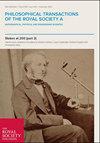水及其同系物:氢键现象的比较
Philosophical Transactions of the Royal Society of London. Series A, Mathematical and Physical Sciences
Pub Date : 2001-08-15
DOI:10.1098/rsta.2001.0868
引用次数: 28
摘要
从氢键相互作用的角度综述了ROH型化合物,特别参考了R = H -, CH3 -和C2H5 -。简述了氢键在生物、气候和宇宙过程中的存在。在水和醇的线性(开放)结构中,二聚体一直是详细的实验和理论研究的主题。水和醇的循环形式也受到了相当大的关注。对水和醇的环状和线性(开放)结构的比较引出了协同性的概念,即通过在两个化合物中形成由现有氢键连接的第二个氢键来加强键合。综述了与其他供体和受体的配合物,包括该类型最简单的化合物H2O…HF,其精确的结构和热力学性质已被报道。水的环状三聚体的瞬态手性已经被认识了一段时间,最近一篇特别有趣的论文测量了水三聚体与吲哚化合物配合物的右手(或顺时针)和左手(或逆时针)形式。这可能对最近认识到甲醇和乙醇也以环三聚体的手性形式存在,也可能是环四聚体的一种形式。希望未来的工作将导致对氢键的更好理解。一个特别重要的领域涉及控制非常快速的分子变化的动态因素,这些变化与氢键在与所有形式的生命相关的生物和物理过程中的核心作用有关。本文章由计算机程序翻译,如有差异,请以英文原文为准。
Water and its homologues: a comparison of hydrogen–bonding phenomena
Compounds of the type ROH are reviewed in terms of hydrogen–bonding interactions with special reference to R = H–, CH3– and C2H5–. The existence of hydrogen bonding in biological, climatic and cosmic processes is briefly described. In linear (open) structures of water and alcohols, the dimers have been the subject of detailed experimental and theoretical study. Cyclic forms of water and alcohols have also received considerable attention. Comparisons of cyclic and linear (open) structures of water and alcohols have led to the concept of cooperativity, by which bonding is strengthened by the formation of a second hydrogen bond within two compounds joined by an existing hydrogen bond. Complexes with other donor and acceptors are reviewed, including the simplest compound of this type, H2O...HF, for which accurate structural and thermodynamic properties have been reported. The transient chirality of the cyclic trimer of water has been recognized for some time and a particularly interesting recent paper measures the right–handed (or clockwise) and left–handed (or anticlockwise) form of the complex of water trimer with indole compounds. This has possible implications for the more recent recognition that methanol and ethanol also exist in chiral forms as cyclic trimers and possibly also as one of the forms of a cyclic tetramer. It is hoped that future work will lead to a better understanding of hydrogen bonding. A particularly important area concerns the dynamic factors controlling the very fast molecular changes that are associated with the central role of hydrogen bonding in the biological and physical processes associated with all forms of life.
求助全文
通过发布文献求助,成功后即可免费获取论文全文。
去求助
来源期刊
自引率
0.00%
发文量
0

 求助内容:
求助内容: 应助结果提醒方式:
应助结果提醒方式:


